By:
- Debra Bass
Published Date
By:
- Debra Bass
Share This:
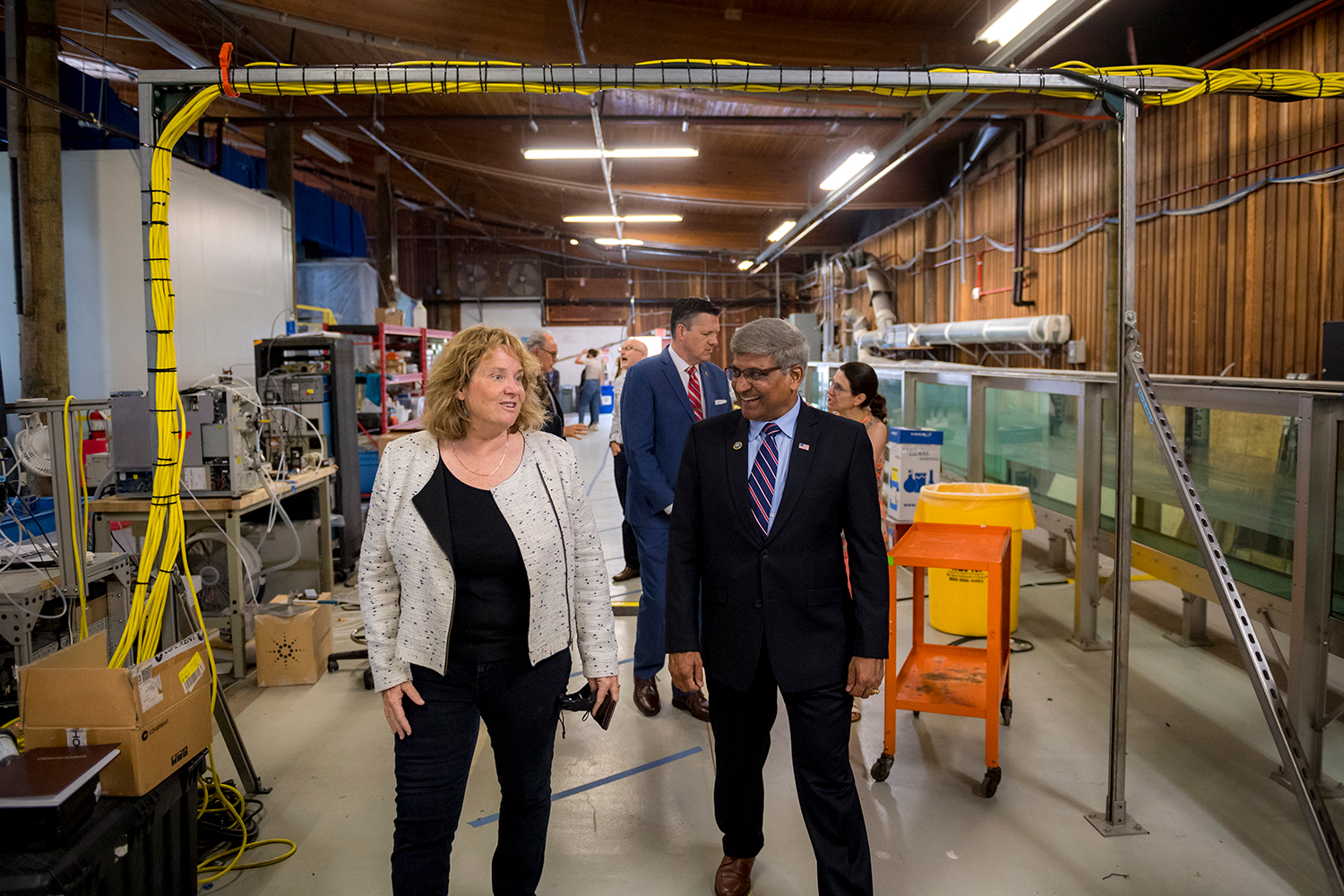
Professor Kimberly Prather discusses climate, aerosols and atmospheric chemistry with National Science Foundation Director Sethuraman Panchanathan during a tour of the Maker Space in Scripps Institution of Oceanography’s Hydraulics Laboratory. Photos by Erik Jepsen/University Communications.
NSF Director Touts Magnitude of UC San Diego Research and Outreach During Visit
UC San Diego research initiatives, including nanoengineering, earthquake safety and ocean science, received a huge endorsement from the National Science Foundation director and key members of his team during a jam-packed visit last week.
“San Diego exemplifies the spirit of what curiosity and discovery-based university research can do—unleashing energy to power innovation, startup companies and an ecosystem of public-private partnerships all coming together as a region,” NSF Director Sethuraman Panchanathan said. “This is a microcosm of what the nation is in some senses and also what the nation needs to be in all senses.”
UC San Diego receives more research funds from NSF than any other University of California campus—$167 million this fiscal year alone. There has been more than a 33 percent increase in funding in the last 5 years due to the significance, scope and importance of research efforts on campus.
Panchanathan, and his team, including his chief of staff and assistant directors of geoscience and engineering, were on campus for a full day of tours, roundtable discussions and a seismic grand reopening.
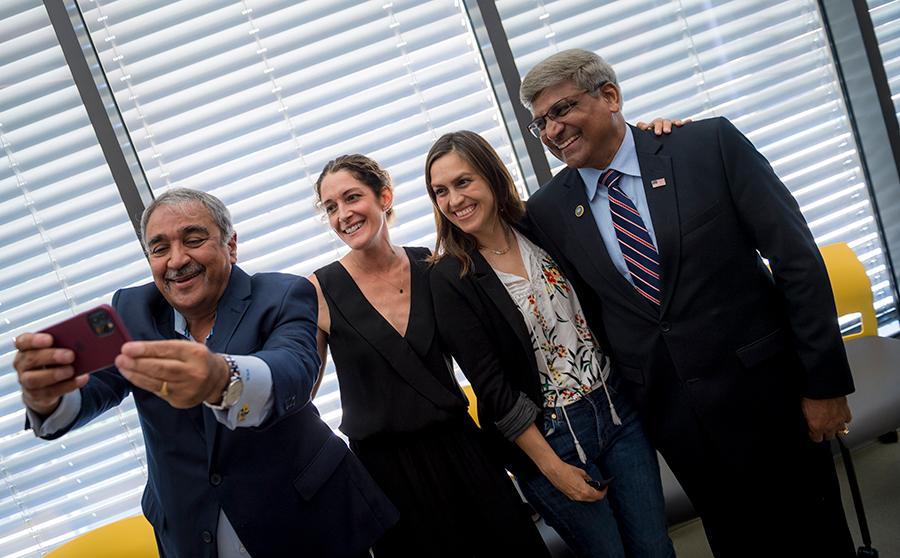
Chancellor Pradeep K. Khosla takes a selfie with professors Rommie Amaro (chemistry and biochemistry) and Elizabeth Villa (molecular biology), and NSF Director Panchanathan, after the professors gave a presentation on the role of technology and the power of computing to understand health.
The day began at Scripps Institution of Oceanography with a demonstration of the new Scripps Ocean-Atmosphere Research Simulator (SOARS), a first-of-its-kind simulator that replicates ocean and atmospheric conditions from tropical to polar temperatures, and ended at the Englekirk Structural Engineering Center’s shake table, the world’s largest and most powerful outdoor earthquake simulator.
The two capstone projects exemplify why the university has been so successful in securing national funding to advance scientific exploration and speed practical applications in the marketplace of ideas and products.
Designing a better future
Panchanathan, who oversees NSF’s $8.8 billion budget, said that the variety and breadth of public and private partnerships creating marketable products and innovations on campus is impressive. There were presentations from early career award recipients, internationally accomplished scientists and creators in dozens of fields.
Among the presentations at UC San Diego’s Design and Innovation Building were a military-inspired initiative to build indestructible 3D-imaging equipment capable of producing medical-grade equipment and other essential gear on-demand (Craitor, Inc) and a first-of-its-kind biodegradable “plant knit” woven into stylish, consumer products, such as shoes that can be composted (Blueview Footwear).
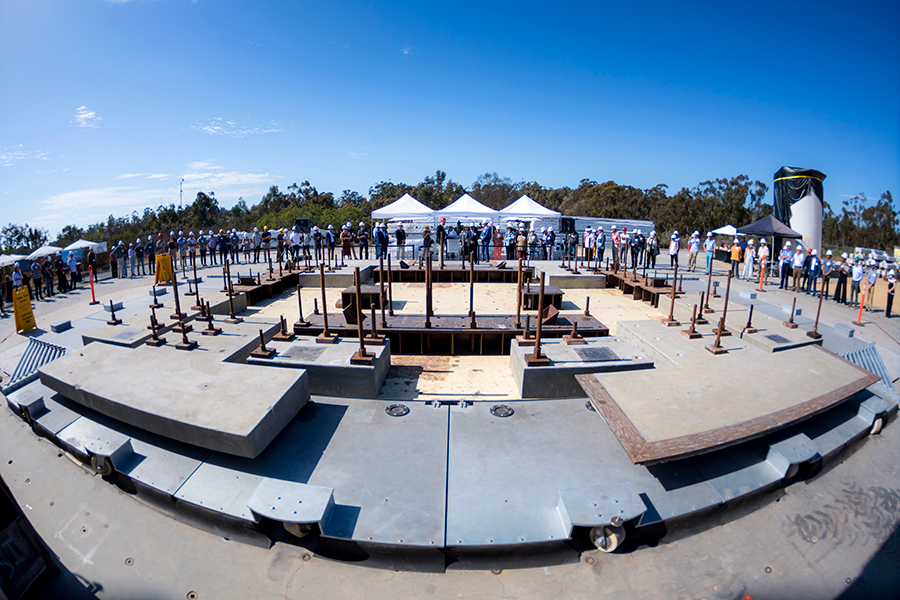
A wide-angle view of a countdown to demonstrate the capabilities of the world’s largest outdoor shake table, housed at UC San Diego’s Englekirk Structural Engineering Center and funded largely with support from NSF.
The day’s conversations centered around not just science and public health—solar power grid technology, artificial intelligence, biochemistry and molecular biology—but workforce development and creating economies of scale.
Promoting the principles behind the Technology, Innovation and Partnerships (TIP) Directorate currently being debated in Congress, Panchanathan asked nearly everyone how they were using what they learned to mentor others, grow scientific interest in underserved populations, develop partnerships and scale up their efforts or operations.
“These were not trick questions,” Panchanathan said. “I am really interested in the exemplar nature of what happens here at UC San Diego, but we can’t contain all these resources and ideas here. We have to use them to inspire talent across the nation. National security, good health and our collective economic prosperity depend on it.”
Chancellor Pradeep K. Khosla agreed that as a nation, we can’t afford to have silos of ideas, resources or information. Everyone has to work together, across nations and across disciplines. That starts with working across every racial and socio-economic sector of the United States.
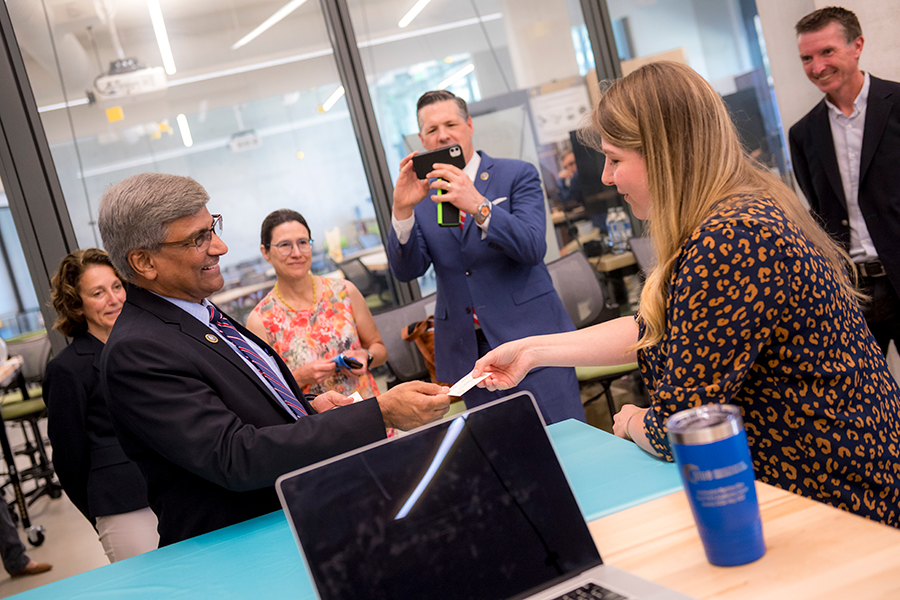
Panchanathan accepts a business card from Kim Pendergrass, a UC San Diego MBA graduate and co-founder of Algeon Materials, during a presentation in The Basement, a networking and startup development space at the Design and Innovation Building. In the background: NSF Assistant Directors Susan Margulies (engineering) and Susan Margulies (geosciences); Chief of Staff Brian Stone and Paul Roben, UC San Diego’s Associate Vice Chancellor for Innovation and Commercialization.
“Diversity brings a diversity of thought and diversity of experiences but, to me, the most significant part is that it makes a statement that everybody is valued and needs to be involved,” Khosla said. “You cannot say only population X can lead the way to a dominant United States economy and intellectual community. Our U.S. exceptionalism is enabled by the diversity of the entire population of the United States. Period.”
And because Panchanathan also asked repeatedly for ways that NSF and federal funding agencies can improve, Khosla suggested that intellectual property laws need to be strengthened internationally so that much-needed collaborations aren’t hindered by a lack of confidence that groundbreaking efforts will be protected in the global marketplace.
Strength in outreach
Vice Chancellor for Research Corinne Peek-Asa, who led the team coordinating the NSF visit and moderated the day’s discussions and roundtables, made it very clear that what’s happening at UC San Diego is meant to be shared and replicated.
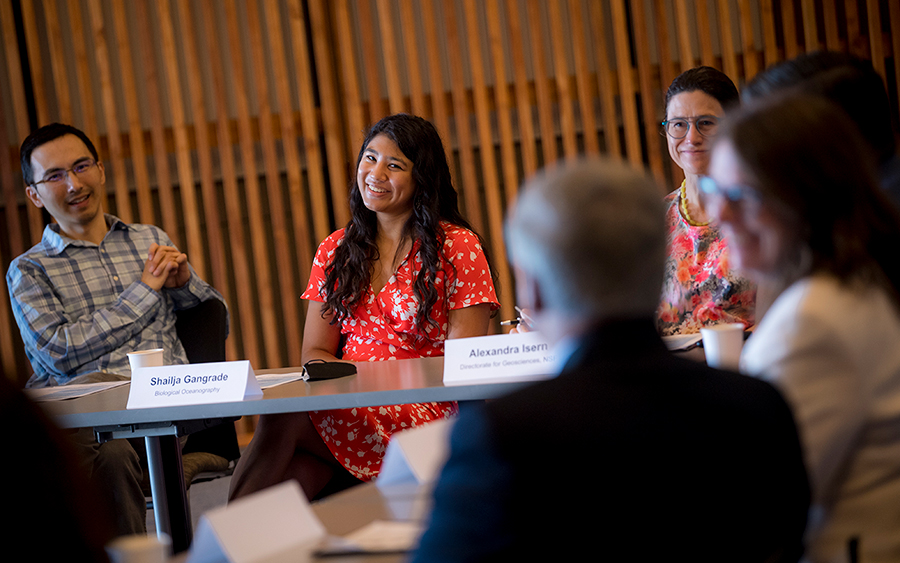
Shailja Gangrade (center), a Ph.D. candidate in applied ocean sciences, discusses the NSF graduate research fellowship that made her work at Scripps Institution of Oceanography possible. She’s playing it forward by encouraging and mentoring others from underrepresented communities.
“We don’t want to be a best-kept secret. Our strength here at UC San Diego is the spaces we’ve created for teams of people, faculty, students, community members and industry leaders to connect, interact and inspire one another,” Peek-Asa said.
She noted that NSF funding alone has led to nearly 700 inventions and more than 1,700 patent applications in the last 25 years. These are examples of science, business, graphic design, government affairs, social science and more coming together.
The formal day ended at the outdoor earthquake simulator—part of the Natural Hazards Engineering Research Infrastructure (NHERI), a nation-wide, shared-use network of facilities—located a few miles east of campus and funded largely through NSF grants. The shake table is open to researchers from all around the nation, and the world, as well as industry partners.
Panchanathan led the countdown on a demonstration of the powerful engineering feat, simulating the 6.7 magnitude, 1994 Northridge (Los Angeles) earthquake, the most costly U.S. earthquake in the last 100 years.
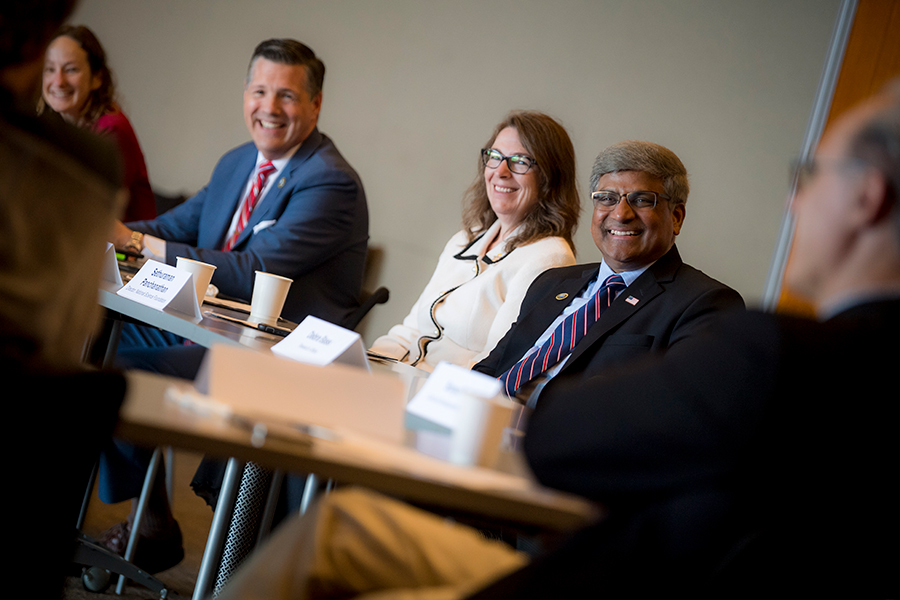
During the morning roundtable discussion of NSF early career faculty awardees and graduate fellows, NSF Chief of Staff Brian Stone, Vice Chancellor for Research Corinne Peek-Asa and Panchanathan share a laugh during a presentation.
Commonly known as a shake table, the one-of-a-kind facility has received funds from NSF since its opening in 2004 to test large and full-size civil infrastructure. A 5-year NSF-funded $16.9 million expansion of the simulator's range of motion was completed this year.
Now, the UC San Diego shake table can put to the test the tallest and heaviest structures in the world, all in “six degrees of freedom”—up, down, side to side, front to back and in shifting wave-like patterns, known as roll, pitch and yaw. This winter, it will shake a 10-story, cross-laminated timber building, the tallest structure to ever be tested on the table.
“Last year alone, natural disasters caused a total of $145 billion in damages across the United States and resulted in nearly 700 deaths. These events do not happen once a lifetime, once a decade, or once a year. Disasters like wildfires, severe storms, and earthquakes are ever-present,” Panchanathan said, making note of a 7.1 magnitude earthquake that occurred in 2018 in Anchorage, Alaska that is still causing aftershocks.
Seismic shifts
Both SOARS (ocean simulator) and the shake table are poised to provide a better understanding of our natural and built environment, contributing to changes in building codes, water treatment processes, healthcare diagnoses, city planning and federal policies. Khosla said that these initiatives were never initiated to stop with the science. They were all meant to spark action, a concept that Panchanathan called “STEM spark.”
“Not every child will become a scientist or pursue a career in STEM, but they may have a better appreciation of the scientific spirit that makes complex international projects like these possible. This STEM spark must be ignited in every child,” he said.
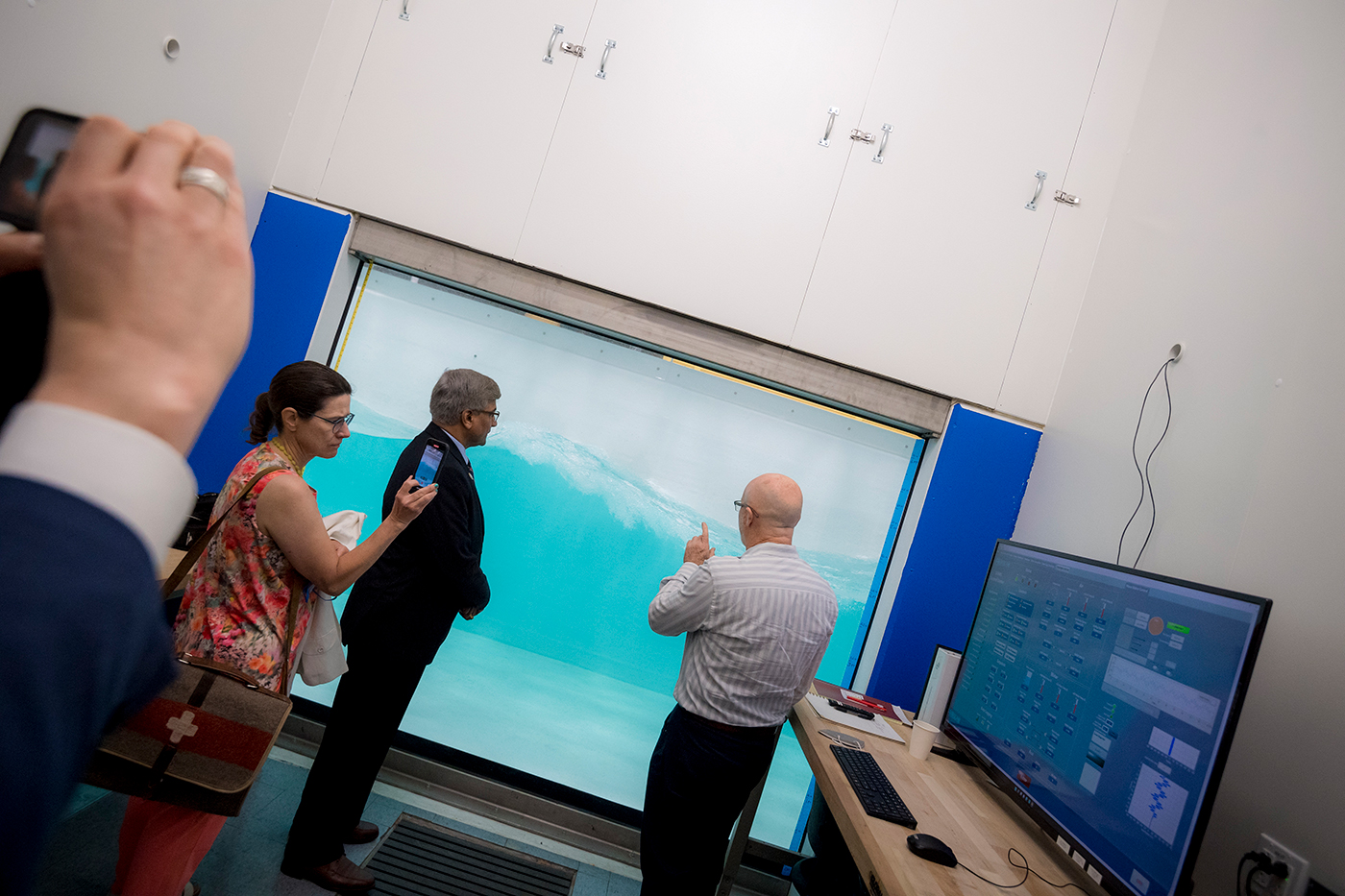
NSF Director Panchanathan gets a close-up demonstration of the new Scripps Ocean-Atmosphere Research Simulator funded largely with NSF support. The $4 million device holds up to 36,000 gallons of water and spans 120 feet.
Panchanathan said that a lifelong appreciation of what science makes possible was instilled in him from a simple exhibit of moon rocks by the U.S. consulate in India. An accomplished computer scientist and engineer who now leads a multibillion-dollar federal agency, Panchanathan said that we can’t know where the spark will lead but we must try.
To that end, the NSF staff ended the day at an exhibition of the brand new Little Blue Penguin habitat at Birch Aquarium, one of UC San Diego’s most approachable outlets to spark public and youth interest in science. The tiny ambassadors are meant to instigate conversations about climate change, ocean health and conservation.
Share This:
You May Also Like
ALERTCalifornia Awarded 2025 Special Achievement in Geographic Information Systems (GIS) by Esri
Science & EnvironmentStay in the Know
Keep up with all the latest from UC San Diego. Subscribe to the newsletter today.



